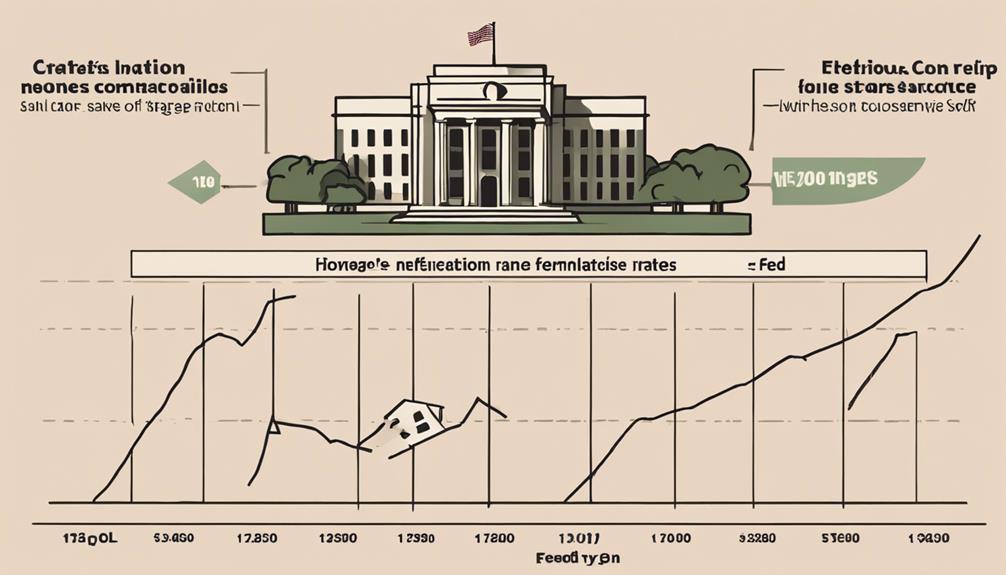When it comes to mortgage rates, you might assume the Federal Reserve holds all the cards, but that’s not entirely accurate.
While the Fed does impact certain interest rates, the connection to mortgage rates is more nuanced.
Understanding the intricate interplay of various factors influencing mortgage rates can provide valuable insights into why the Federal Reserve’s control over them is not as direct as commonly perceived.
Stay tuned to uncover the complexities behind this often-misunderstood relationship.
Historical Relationship Between Fed Rates and Mortgage Rates
Historically, mortgage rates haven’t always moved in direct correlation with Federal Reserve rates. While the Federal Reserve can influence short-term interest rates through its monetary policy, mortgage rates are more heavily influenced by long-term market forces.
For example, during periods of economic uncertainty, investors tend to seek safer investments like bonds, leading to lower mortgage rates. Conversely, in times of economic growth, lenders may increase rates to mitigate risks. Additionally, factors such as inflation, housing market conditions, and global economic trends play significant roles in determining mortgage rates.
Understanding this historical relationship can help you make informed decisions when considering buying or refinancing a home.
Market Forces Driving Mortgage Rates
When considering mortgage rates, market forces play a crucial role in their determination. Mortgage rates are influenced by factors such as supply and demand dynamics in the housing market, the overall health of the economy, and investor sentiment.
For instance, when the economy is strong, demand for loans increases, leading to higher mortgage rates. Conversely, during economic downturns, demand weakens, causing rates to fall. Additionally, global economic conditions, inflation expectations, and geopolitical events can all impact mortgage rates.
Lenders also consider the level of risk associated with lending money when setting rates. Understanding these market forces can help you make informed decisions when it comes to obtaining a mortgage.
Influence of Economic Indicators on Rates
Economic indicators play a significant role in influencing mortgage rates, reflecting the current state of the economy. When indicators like GDP growth, unemployment rates, and inflation show positive trends, mortgage rates tend to rise as lenders adjust to the healthier economy.
On the other hand, if economic indicators suggest a slowdown or instability, mortgage rates may decrease to stimulate borrowing and investments. For example, low unemployment rates coupled with steady wage growth might signal an upcoming increase in mortgage rates.
Understanding how economic indicators impact mortgage rates can help you make informed decisions when considering buying a home or refinancing your existing mortgage. Keep an eye on these indicators to gauge potential changes in mortgage rates and plan accordingly.
Role of Investors in Mortgage Rate Determination
Investors play a crucial role in determining mortgage rates, influencing market dynamics and borrower costs. When investors are willing to buy mortgage-backed securities (MBS), it drives demand for these investments. As demand increases, MBS prices go up, and their yields (interest rates) go down.
Conversely, if investors are less interested in MBS, prices drop, and yields rise. This dynamic directly affects mortgage rates offered to consumers. Investors’ perceptions of economic conditions, inflation expectations, and global events all impact their decisions to buy MBS.
Understanding investor behavior and market trends can help you anticipate potential mortgage rate changes and make informed decisions when considering home financing options.
Misconceptions About Federal Reserve’s Role
Despite common misconceptions, the Federal Reserve doesn’t directly control mortgage rates. The Fed’s primary responsibility is to regulate the nation’s monetary policy by influencing interest rates through its open market operations.
While the Federal Reserve’s decisions can indirectly impact mortgage rates, it doesn’t set specific rates for home loans. Mortgage rates are primarily determined by the interaction of various economic factors like inflation, economic growth, and bond yields.
Investors, market conditions, and global events also play significant roles in shaping mortgage rate trends. Understanding that the Federal Reserve’s role is more nuanced and indirect can help you make informed decisions about mortgage financing, considering a broader range of factors beyond just the Fed’s actions.
Conclusion
So, next time you hear someone say that the Federal Reserve controls mortgage rates, you can confidently correct them.
While the Fed does play a role in shaping the overall economic environment, mortgage rates are primarily influenced by market forces, economic indicators, and investor behavior.
Understanding these factors can help you make informed decisions when it comes to financing your home.




